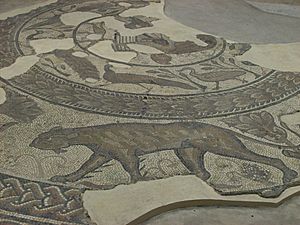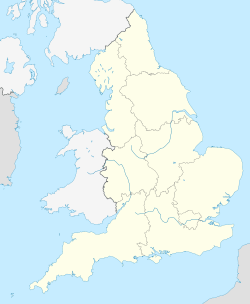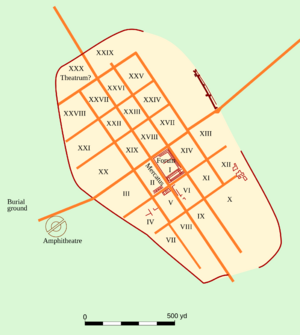Corinium Dobunnorum facts for kids

A Roman mosaic in the Corinium Museum in Cirencester
|
|
| Location | Cirencester, Gloucestershire, England |
|---|---|
| Region | Britannia |
| Coordinates | 51°43′08″N 01°58′05″W / 51.71889°N 1.96806°W |
| Type | Settlement |
| History | |
| Founded | Mid-70s CE |
| Abandoned | Possibly around 430 |
| Periods | Roman Imperial |
Corinium Dobunnorum was an important town in Roman Britain. It was located where the town of Cirencester is today, in Gloucestershire, England. In the 2nd century, its walls covered the second-largest area of any city in Roman Britain.
Corinium was the main town, or civitas, for the Dobunni tribe. These were a friendly local tribe. It is also believed to have been the capital of the Roman province called Britannia Prima.
Contents
A Roman Army Fort
The Romans first built a fort at Corinium. This happened about a year after they conquered Britain. The main local settlement at that time was a hillfort at Bagendon.
Corinium was an important meeting point for Roman roads. Three major Roman roads met there: the Fosse Way, Akeman Street, and Ermin Street.
A Busy Tribal Capital
By the mid-70s CE, the Roman army left the fort. The site then became the main town for the Dobunni tribe. Over the next 20 years, the town grew a lot.
The Romans built a street plan and many large public buildings. There were also two market places, shops, and private homes. The town's main public square, called the forum, and its large hall, the basilica, were huge. Only Londinium (modern-day London) had bigger ones in Britain.
The basilica had beautiful carvings and fancy marble walls. But it was built over an old fort ditch. This caused the walls to crack and sink. So, it had to be rebuilt in the mid-2nd century.
There was likely a cattle market next to the forum. It had a market hall and several butcher shops. Wooden water pipes show that the town had an aqueduct to bring water. However, no public baths have been found yet.
The town's amphitheatre was built outside the main town. It was in an area now called the Querns. This amphitheatre was built in an old quarry. It was unusual because it lined up with the town's streets.
So far, no Roman temples have been found in Corinium. But many beautiful sculptures show that people were very religious. Some historians think a Christian bishop from Corinium might have attended an important meeting in 314 CE.
The town got strong walls in the late 2nd century. These walls had five gates. Later, round towers were added to the walls. About 50 years after they were built, parts of the walls fell down. They were largely rebuilt. Small rooms were added around the walls. These might have been for animals, prisoners, or small shrines.
Corinium was home to some of the earliest stone houses for wealthy people. Some of these homes date back to the 110s CE. These fancy houses continued to be built and lived in throughout the town's history. They were especially luxurious in the 4th century. Many had beautiful mosaic floors and fine sculptures.
It is thought that Corinium was a center for stone carving and mosaic making. There were also bakers, glass makers, blacksmiths, and goldsmith within the town walls.
A Provincial Capital
Corinium continued to grow until the 4th century. The Roman Empire was divided into smaller areas called provinces. Corinium is now usually believed to have been the capital of the province called Britannia Prima.
The Town's Decline
Around 410 CE, the Romans began to leave Britain. At this time, the town walls of Corinium were repaired. The forum was also kept clean. But the town was finally abandoned around 430 CE.
The amphitheatre area had a large wooden building from the 5th and 6th centuries. It might have been a fortified place for a local king named Cyndyddan. He fought in the Battle of Deorham in 577 CE.
What Remains Today
- The grassy bowl of the amphitheatre, also known as the "Bull Ring", is cared for by English Heritage.
- You can see a small part of the old Roman wall in Abbey Park.
- A large collection of Roman objects from Corinium are on display at the Corinium Museum in Cirencester.
Images for kids




